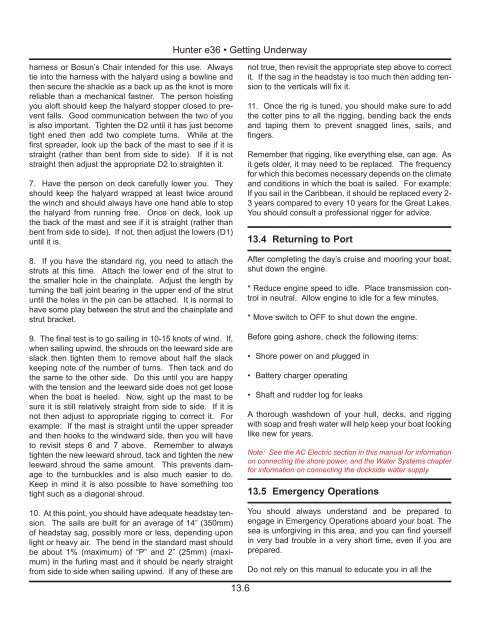36e Operator's Manual 2013.pdf - Marlow-Hunter, LLC
36e Operator's Manual 2013.pdf - Marlow-Hunter, LLC
36e Operator's Manual 2013.pdf - Marlow-Hunter, LLC
- No tags were found...
Create successful ePaper yourself
Turn your PDF publications into a flip-book with our unique Google optimized e-Paper software.
<strong>Hunter</strong> e36 • Getting Underwayharness or Bosun’s Chair intended for this use. Alwaystie into the harness with the halyard using a bowline andthen secure the shackle as a back up as the knot is morereliable than a mechanical fastner. The person hoistingyou aloft should keep the halyard stopper closed to preventfalls. Good communication between the two of youis also important. Tighten the D2 until it has just becometight ened then add two complete turns. While at thefirst spreader, look up the back of the mast to see if it isstraight (rather than bent from side to side). If it is notstraight then adjust the appropriate D2 to straighten it.7. Have the person on deck carefully lower you. Theyshould keep the halyard wrapped at least twice aroundthe winch and should always have one hand able to stopthe halyard from running free. Once on deck, look upthe back of the mast and see if it is straight (rather thanbent from side to side). If not, then adjust the lowers (D1)until it is.8. If you have the standard rig, you need to attach thestruts at this time. Attach the lower end of the strut tothe smaller hole in the chainplate. Adjust the length byturning the ball joint bearing in the upper end of the strutuntil the holes in the pin can be attached. It is normal tohave some play between the strut and the chainplate andstrut bracket.9. The final test is to go sailing in 10-15 knots of wind. If,when sailing upwind, the shrouds on the leeward side areslack then tighten them to remove about half the slackkeeping note of the number of turns. Then tack and dothe same to the other side. Do this until you are happywith the tension and the leeward side does not get loosewhen the boat is heeled. Now, sight up the mast to besure it is still relatively straight from side to side. If it isnot then adjust to appropriate rigging to correct it. Forexample: If the mast is straight until the upper spreaderand then hooks to the windward side, then you will haveto revisit steps 6 and 7 above. Remember to alwaystighten the new leeward shroud, tack and tighten the newleeward shroud the same amount. This prevents damageto the turnbuckles and is also much easier to do.Keep in mind it is also possible to have something tootight such as a diagonal shroud.10. At this point, you should have adequate headstay tension.The sails are built for an average of 14” (350mm)of headstay sag, possibly more or less, depending uponlight or heavy air. The bend in the standard mast shouldbe about 1% (maximum) of “P” and 2” (25mm) (maximum)in the furling mast and it should be nearly straightfrom side to side when sailing upwind. If any of these arenot true, then revisit the appropriate step above to correctit. If the sag in the headstay is too much then adding tensionto the verticals will fix it.11. Once the rig is tuned, you should make sure to addthe cotter pins to all the rigging, bending back the endsand taping them to prevent snagged lines, sails, andfingers.Remember that rigging, like everything else, can age. Asit gets older, it may need to be replaced. The frequencyfor which this becomes necessary depends on the climateand conditions in which the boat is sailed. For example:If you sail in the Caribbean, it should be replaced every 2-3 years compared to every 10 years for the Great Lakes.You should consult a professional rigger for advice.13.4 Returning to PortAfter completing the day’s cruise and mooring your boat,shut down the engine.* Reduce engine speed to idle. Place transmission controlin neutral. Allow engine to idle for a few minutes.* Move switch to OFF to shut down the engine.Before going ashore, check the following items:• Shore power on and plugged in• Battery charger operating• Shaft and rudder log for leaksA thorough washdown of your hull, decks, and riggingwith soap and fresh water will help keep your boat lookinglike new for years.Note: See the AC Electric section in this manual for informationon connecting the shore power, and the Water Systems chapterfor information on connecting the dockside water supply.13.5 Emergency OperationsYou should always understand and be prepared toengage in Emergency Operations aboard your boat. Thesea is unforgiving in this area, and you can find yourselfin very bad trouble in a very short time, even if you areprepared.Do not rely on this manual to educate you in all the13.6

















